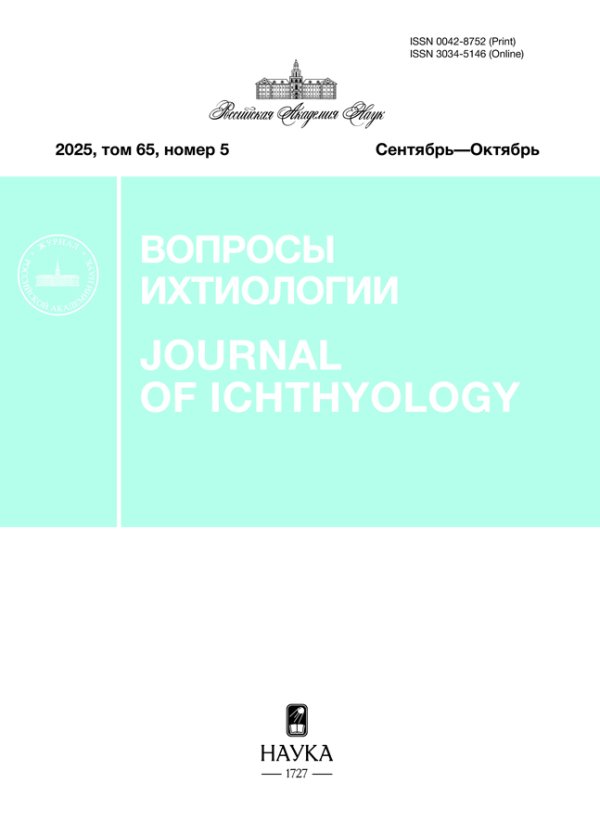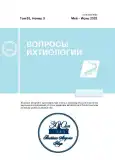The Role of Respawning Individuals in the Reproduction of Atlantic Salmon Salmo salar (Salmonidae). Mathematical Simulation
- Authors: Alekseev M.Y.1
-
Affiliations:
- Polar Branch Russian Federal Research Institute of Fisheries and Oceanography—PINRO, Murmansk, Russia
- Issue: Vol 63, No 3 (2023)
- Pages: 316-322
- Section: Articles
- URL: https://journals.rcsi.science/0042-8752/article/view/135190
- DOI: https://doi.org/10.31857/S0042875223020017
- EDN: https://elibrary.ru/UPQLUO
- ID: 135190
Cite item
Full Text
Abstract
Analysis of long-term fishing and biological data has made it possible to determine the proportion of respawning individuals (the “remainder”) in populations of Atlantic salmon Salmo salar inhabiting large rivers of the Kola Peninsula. The contribution of respawning individuals to the dynamics of the Atlantic salmon population was assessed using the mathematical simulation model. It is shown that the model population becomes more resistant to fishing with increase in the “remainder” proportion; however, the influence of such individuals on the population dynamics is noticeable only when their relative number is more than 5% in the spawning population. The results of different model experiments are interpreted. The role of respawning salmons may be determined not so much by their quantitative contribution to the reproduction process as by the maintenance of the genetic diversity of the population within the reproductive strategy characteristic of the Atlantic salmon
About the authors
M. Yu. Alekseev
Polar Branch Russian Federal Research Institute of Fisheries and Oceanography—PINRO, Murmansk, Russia
Author for correspondence.
Email: mal@pinro.ru
Россия, Мурманск
References
- Азбелев В.В., Громов Г.Д., Лагунов И.И. 1956. О повторном нересте семги // Вопросы ихтиологии внутренних водоемов. Петрозаводск: Гос. изд-во Карельской АССР. С. 131–140.
- Алексеев М.Ю. 2003. Изучение динамики численности нерестового стада атлантического лосося реки Тулома с помощью математической модели // Вопр. рыболовства. Т. 4. № 2 (14). С. 246–263.
- Алексеев М.Ю., Криксунов Е.А. 1999. Современное состояние стада семги реки Умба // Адаптация и эволюция живого населения полярных морей в условиях океанического перигляциала. Апатиты: Изд-во КНЦ РАН. С. 224–231.
- Алексеев М.Ю., Зубченко А.В., Криксунов Е.А. 2006. Применение имитационного математического моделирования для оценки величины нелегального вылова семги (Salmo salar L.) в реке Умба // Вопр. рыболовства. Т. 7. № 2 (26). С. 318–325.
- Алтухов Ю.П. 1995. Внутрипопуляционная компонента генного разнообразия. Генетика популяций и сохранение биоразнообразия // Соросов. образоват. журн. № 1. С. 32–43.
- Бакштанский Э.Л., Яковенко М.Я. 1976. Миграция вальчаков атлантического лосося из р. Варзуга // Тр. ВНИРО. Т. 33. С. 33–38.
- Зубченко А.В., Калюжин С.М., Веселов А.Е. и др. 2007. Особенности воспроизводства атлантического лосося (Salmo salar L.) в реке Умба (Кольский полуостров). Петрозаводск: Скандинавия, 164 с.
- Зюганов В.В. 2005. Долгожитель-паразит, продлевающий жизнь хозяина. Жемчужница Margaritifera margaritifera выключает программу ускоренного старения у лосося Salmo salar // Докл. РАН. Т. 403. № 5. С. 701–705.
- Криксунов Е.А. 1995. Теория пополнения и интерпретация динамики популяций рыб // Вопр. ихтиологии. Т. 35. № 3. С. 302–321.
- Криксунов Е.А., Бобырев А.Е. 2007. Эффекты регуляции во временной и пространственной динамике популяций рыб // Проблемы регуляции в биологических системах. Биофизические аспекты. М.; Ижевск: НИЦ Регулярная и хаотическая динамика; Институт компьютерных исследований. С. 453–471.
- Мартынов В.Г. 1987. Сбор и первичная обработка биологических материалов из промысловых уловов атлантического лосося. Сыктывкар: Изд-во Коми НЦ УРО АН СССР, 36 с.
- Мельникова М.Н. 1962. Методика и результаты мечения вальчаков семги в р. Варзуга в 1958–1959 гг. // Науч.-тех. бюл. ГосНИОРХ. № 15. С. 78–81.
- Решетников Ю.С., Попова О.А., Новоселов А.П. 2016. Современное состояние лососеобразных рыб в водоемах европейского Северо-Востока // Тр. ВНИРО. Т. 162. С. 6–11.
- Рикер У.Е. 1979. Методы оценки и интерпретация биологических показателей популяций рыб. М.: Пищ. пром-сть, 408 с.
- Ducharme L.J.A. 2011. Atlantic salmon returning for their fifth and sixth consecutive spawning trips // J. Fish. Res. Board Can. V. 26. № 6. P. 1661–1664. https://doi.org/10.1139/f69-149
- Gray R.W., Cameron J.D., McLennan A.D. 1987. Artificial reconditioning, spawning and survival of Atlantic salmon, Salmo salar L., kelts in salt water and survival of their Fl progeny // Aquac. Res. V. 18. № 4. P. 309–326. https://doi.org/10.1111/j.1365-2109.1987.tb00321.x
- Halttunen E., Jensen J.L.A., Næsje T.F. et al. 2013. State-dependent migratory timing of postspawned Atlantic salmon (Salmo salar) // Can. J. Fish. Aquat. Sci. V. 70. № 7. P. 1063–1071. https://doi.org/10.1139/cjfas-2012-0525
- Hubley P.B., Amiro P.G., Gibson A.J.F. et al. 2008. Survival and behaviour of migrating Atlantic salmon (Salmo salar L.) kelts in river, estuarine, and coastal habitat // ICES J. Mar. Sci. V. 65. № 9. P. 1626–1634. https://doi.org/10.1093/icesjms/fsn129
- Hughes P.W. 2017. Review between semelparity and iteroparity: empirical evidence for a continuum of models of parity // Ecol. Evol. V. 7. № 20. P. 8232–8261. https://doi.org/10.1002/ece3.3341
- Jokikokko E., Jutila E. 2005. Effect of fishing regulation on the occurrence of repeat spawners and age distribution of Atlantic salmon in a northern Baltic river // Fish. Manag. Ecol. V. 12. № 5. P. 341–347. https://doi.org/10.1111/j.1365-2400.2005.00457.x
- Jonsson N., Hansen L.P., Jonsson B. 1991. Variation in age, size and repeat spawning of adult Atlantic salmon in relation to river discharge // J. Anim. Ecol. V. 60. № 3. P. 937–947. https://doi.org/10.2307/5423
- Mobley K.B., Aykanat T., Czorlich Y. et al. 2021. Maturation in Atlantic salmon (Salmo salar, Salmonidae): a synthesis of ecological, genetic, and molecular processes // Rev. Fish Biol. Fish. V. 31. № 3. P. 523–571. https://doi.org/10.1007/s11160-021-09656-w
- Niemelä E., Orell P., Erkinaro J. et al. 2006. Previously spawned Atlantic salmon ascend a large subarctic river earlier than their maiden counterparts // J. Fish Biol. V. 69. № 4. P. 1151–1163. https://doi.org/10.1111/j.1095-8649.2006.01190.x
- Reid J.E., Chaput G. 2012. Spawning history influence on fecundity, egg size, and egg survival of Atlantic salmon (Salmo salar) from the Miramichi River, New Brunswick, Canada // ICES J. Mar. Sci. V. 69. № 9. P. 1678–1685. https://doi.org/10.1093/icesjms/fss091
- Talbot C., Stagg R., Eddy F. 1992. Renal, respiratory and ionic regulation in Atlantic salmon (Salmo salar L.) kelts following transfer from fresh water to seawater // J. Comp. Physiol. B. V. 162. № 4. P. 358–364. https://doi.org/10.1007/BF00260764
Supplementary files














